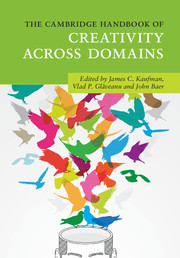Book contents
- The Cambridge Handbook of Creativity Across Domains
- The Cambridge Handbook of Creativity Across Domains
- Copyright page
- Dedication
- Contents
- Figures
- Tables
- Contributors
- Acknowledgments
- Part I Creativity and Domain
- Part II Creativity in the Traditional Arts
- 5 The Creativity of Literary Writing
- 6 Creativity in the Visual Arts
- 7 The Creation and Aesthetic Appreciation of Architecture
- 8 Photography and Creativity
- 9 The Constricted Muse
- 10 Musical Creativity
- 11 Dance
- Part III Creativity in the Sciences
- Part IV Creativity in Business
- Part V Newer Domains for Creativity Research
- Part VI Creativity in Everyday Life
- Part VII Conclusion
- Index
- References
7 - The Creation and Aesthetic Appreciation of Architecture
from Part II - Creativity in the Traditional Arts
Published online by Cambridge University Press: 15 September 2017
- The Cambridge Handbook of Creativity Across Domains
- The Cambridge Handbook of Creativity Across Domains
- Copyright page
- Dedication
- Contents
- Figures
- Tables
- Contributors
- Acknowledgments
- Part I Creativity and Domain
- Part II Creativity in the Traditional Arts
- 5 The Creativity of Literary Writing
- 6 Creativity in the Visual Arts
- 7 The Creation and Aesthetic Appreciation of Architecture
- 8 Photography and Creativity
- 9 The Constricted Muse
- 10 Musical Creativity
- 11 Dance
- Part III Creativity in the Sciences
- Part IV Creativity in Business
- Part V Newer Domains for Creativity Research
- Part VI Creativity in Everyday Life
- Part VII Conclusion
- Index
- References
Summary
Psychologists have historically been interested in architecture as an important domain within which to study creativity. Classic studies highlighted the role of personality variables, while at the same time downplaying the contributions of some cognitive abilities (e.g., intelligence) to individual differences in architectural creativity. Recently, research in this domain has been informed by novel findings from psychology, neuropsychology, and neuroscience. Specifically, architectural creativity has been linked to the flexible interplay between associative and inferential processes, the neural systems for which are dissociable in the brain. In addition, evidence suggests that high-level creativity in architecture could in part be driven by ordinary thought processes working on exceptionally rich content. In turn, neuroimaging studies have begun to also shed light on the neural bases of our aesthetic appreciation of various basic features of architectural design such as contour, ceiling height, and perceived enclosure. Together, these various strands of research are increasing our understanding of creativity and aesthetic appreciation in the domain of architecture.
- Type
- Chapter
- Information
- The Cambridge Handbook of Creativity across Domains , pp. 110 - 122Publisher: Cambridge University PressPrint publication year: 2017
References
- 2
- Cited by



